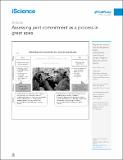Files in this item
Assessing joint commitment as a process in great apes
Item metadata
| dc.contributor.author | Heesen, Raphaela | |
| dc.contributor.author | Bangerter, Adrian | |
| dc.contributor.author | Zuberbühler, Klaus | |
| dc.contributor.author | Iglesias, Katia | |
| dc.contributor.author | Neumann, Christof | |
| dc.contributor.author | Pajot, Aude | |
| dc.contributor.author | Perrenoud, Laura | |
| dc.contributor.author | Guéry, Jean-Pascal | |
| dc.contributor.author | Rossano, Federico | |
| dc.contributor.author | Genty, Emilie | |
| dc.date.accessioned | 2021-08-23T14:30:11Z | |
| dc.date.available | 2021-08-23T14:30:11Z | |
| dc.date.issued | 2021-08-20 | |
| dc.identifier | 275504234 | |
| dc.identifier | 1cb792e5-077d-4b56-91bc-61f820cf80bc | |
| dc.identifier | 000686897200059 | |
| dc.identifier | 85119210250 | |
| dc.identifier.citation | Heesen , R , Bangerter , A , Zuberbühler , K , Iglesias , K , Neumann , C , Pajot , A , Perrenoud , L , Guéry , J-P , Rossano , F & Genty , E 2021 , ' Assessing joint commitment as a process in great apes ' , iScience , vol. 24 , no. 8 , 102872 . https://doi.org/10.1016/j.isci.2021.102872 | en |
| dc.identifier.issn | 2589-0042 | |
| dc.identifier.other | RIS: urn:D32BCD1CCF93A445452A3ADB0A8DD357 | |
| dc.identifier.other | ORCID: /0000-0001-8378-088X/work/98784966 | |
| dc.identifier.uri | https://hdl.handle.net/10023/23816 | |
| dc.description | Research was funded by Swiss National Science Foundation (Grant No. CR31I3_166331 awarded to A.B. and K.Z.). | en |
| dc.description.abstract | Many social animals interact jointly, but only humans experience a specific sense of obligation toward their co-participants, a joint commitment. However, joint commitment is not only a mental state but also a process that reveals itself in the coordination efforts deployed during entry and exit phases of joint action. Here, we investigated the presence and duration of such phases in N = 1,242 natural play and grooming interactions of captive chimpanzees and bonobos. The apes frequently exchanged mutual gaze and communicative signals prior to and after engaging in joint activities with conspecifics, demonstrating entry and exit phases comparable to those of human joint activities. Although rank effects were less clear, phases in bonobos were more moderated by friendship compared to phases in chimpanzees, suggesting bonobos were more likely to reflect patterns analogous to human “face management”. This suggests that joint commitment as process was already present in our last common ancestor with Pan. | |
| dc.format.extent | 19 | |
| dc.format.extent | 1986562 | |
| dc.language.iso | eng | |
| dc.relation.ispartof | iScience | en |
| dc.subject | Biological sciences | en |
| dc.subject | Ethology | en |
| dc.subject | Behavioral neuroscience | en |
| dc.subject | QL Zoology | en |
| dc.subject | BF Psychology | en |
| dc.subject | NDAS | en |
| dc.subject.lcc | QL | en |
| dc.subject.lcc | BF | en |
| dc.title | Assessing joint commitment as a process in great apes | en |
| dc.type | Journal article | en |
| dc.contributor.institution | University of St Andrews. School of Psychology and Neuroscience | en |
| dc.contributor.institution | University of St Andrews. Institute of Behavioural and Neural Sciences | en |
| dc.contributor.institution | University of St Andrews. Centre for Social Learning & Cognitive Evolution | en |
| dc.identifier.doi | https://doi.org/10.1016/j.isci.2021.102872 | |
| dc.description.status | Peer reviewed | en |
| dc.identifier.url | https://www.sciencedirect.com/science/article/pii/S2589004221008403?dgcid=raven_sd_search_email#appsec2 | en |
This item appears in the following Collection(s)
Items in the St Andrews Research Repository are protected by copyright, with all rights reserved, unless otherwise indicated.

